The Ultimate Guide to Tskaltubo, Georgia’s Soviet Spa Town (original) (raw)
This comprehensive guide to visiting Tskaltubo covers 25+ sanatoria and bathhouses along with useful visitor’s tips, transport instructions, and a Tskaltubo map.
Home of the famous ‘Waters of Immortality’ and once the most sought-after R&R destination in the USSR, Tskaltubo – with its semi-abandoned sanatoriums and timeworn bathhouses – now attracts a very different type of tourist.
Nowadays, this is Georgia’s most popular dark tourism destination.
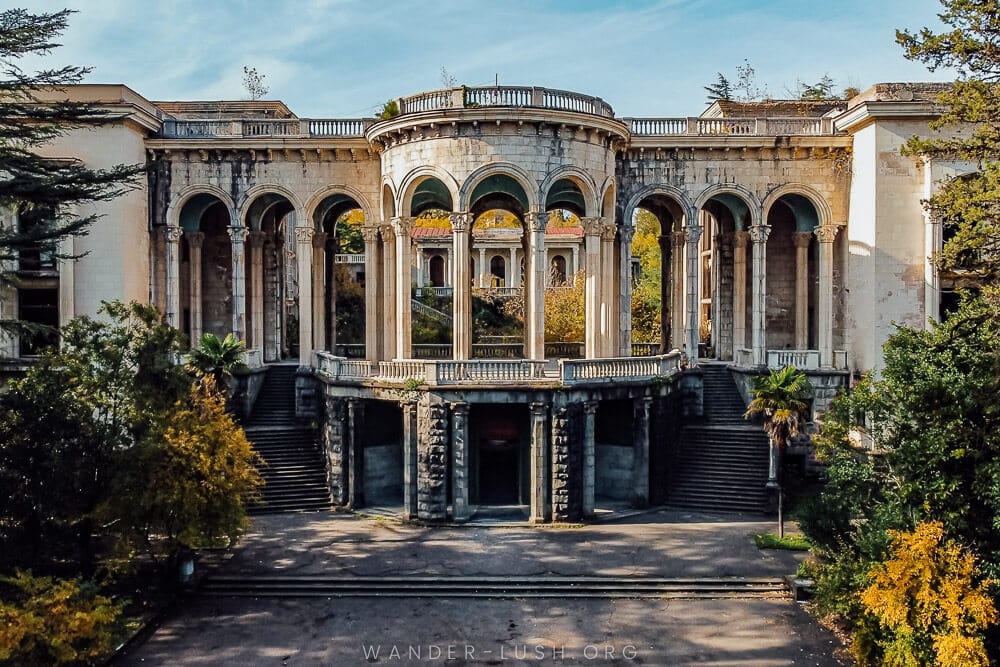
Sanatorium Medea, one of my favourite places in Tskaltubo.
Located just 20 minutes north-west of Kutaisi and accessible by marshrutka, it’s a convenient day trip from the country’s fourth-biggest city.
A blast from the Soviet past, Tskaltubo is a wonderland for urbexers, architecture aficionados and photographers alike. The town is dripping with history and has a very unusual vibe. Along with the mining town of Chiatura, it’s one place in Georgia that I keep going back to again and again – and I’m still not tired of exploring.

Nature takes over in Tskaltubo.
After half a dozen visits to Tskaltubo, I’ve seen the lion’s share of the sanatoria, hotels and bathhouses (around 25 in total), stayed overnight in the only refurbished sanatorium, and scouted out a bunch of other interesting Soviet-era landmarks and things to see.
I’ve also seen firsthand how Tskaltubo is changing – and let me tell you, it’s changing fast. With several more sanatoriums now in the hands of private investors and construction work underway, there is limited time left to see Tskaltubo in its current state.
This guide brings together everything I’ve learned and experienced to help you plan the perfect visit to Tskaltubo.
Please note: This post contains affiliate links, meaning I may earn a commission if you make a purchase by clicking a link (at no extra cost to you). Learn more.
Watch my Tskaltubo video!
A quick history of Tskaltubo
Georgia’s curative mineral waters and natural sulfur springs have been attracting bathers for eons. When the country was part of the Russian Empire, spa resorts were established all over the place, including in Abastumani, Borjomi and Menji.
The ground beneath Tskaltubo (literally ‘a place of water’) is coursing with radon-carbonate mineral springs, which have a natural temperature of 33-35°C and are believed to be good for the cardiovascular and endocrine systems, arthritis and rheumatism – among other things.
Inside Central Park you will find a modern pavilion with a natural fountain where you can feel the warm waters with your hand (the exact location is marked on my Tskaltubo Map).

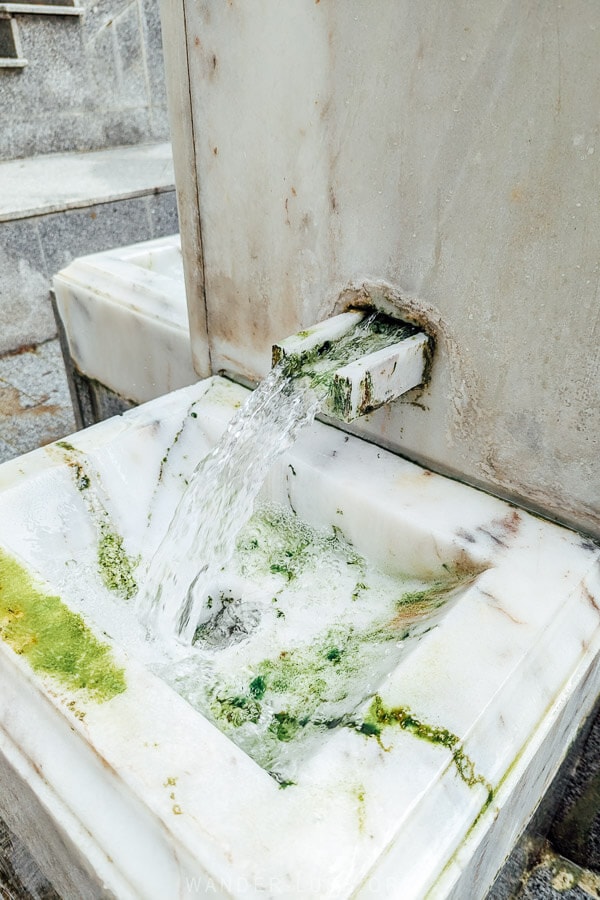
Tskaltubo’s so-called ‘Waters of Immortality’ were first documented in the 13th century. According to one legend, a local shepherd happened upon the springs. Others attribute the discovery to the noble Ioseli family.
The first bathhouses were built as early as the 1870s. In 1913, the Latvian chemist Robert Kuptsis was invited to analyse the waters and was the first person to detect radon – a discovery that sped-up the development of the resort.
In Soviet times, especially in the years after WWII, Tskaltubo became the most popular and developed of Georgia’s spa towns.
Tskaltubo in the Soviet period
In the 1920s, the territory of Tskaltubo was acquired by the state and in 1931, it was declared a balneotherapy centre – a place for the treatment of medical conditions using mineral water.
That was the same year Joseph Stalin (allegedly) first visited Tskaltubo. As the story goes, he was prescribed balneological treatment by his doctor in Moscow to help with leg pain. Three spa houses were erected ahead of his visit in record time thanks to the 4,000 labourers who were enlisted for the project.
Stalin (again, allegedly!) visited Tskaltubo for a second time in 1951, accompanied by Lavrenti Beria. He had private quarters in at least one sanatorium, the Soviet Union Ministry of Defence sanatorium (now Tskaltubo Spa Resort), his own bathroom at Bathhouse No 6, and even a summer house on a hill nearby.

A Stalin poster spotted amongst the debris inside one of Tskaltubo’s sanatoriums.
By the 1950s, Tskaltubo Central Park – the large green space in the centre of town – housed nine bath houses and wellness centres. Meanwhile 22 ‘Soviet neoclassicist’ sanatoria and hotels were erected around the edge of the park to accommodate guests. Most of these buildings were jointly designed by Georgian and Russian architects.
Since the mineral waters lose their healing properties within 3-4 minutes after being released, they can’t be pumped or bottled. Only the spas in the ‘baleonology zone’ have access to the springs, thus treatments were only offered inside the park.
At its peak, up to 125,000 people from across the USSR visited the town every year for their state-mandated R&R. There were even direct trains to Tskaltubo from Moscow.
Prestigious as it was, Tskaltubo wasn’t necessarily reserved for the upper echelons. It was mainly frequented by party members, factory administration workers, and the political elite – but anyone could theoretically attend Tskaltubo under Article 119 of the USSR Constitution, ‘the right to rest and leisure’.

Bathing in Tskaltubo.
The average price of a visit was 120 Soviet rubles (for context, a middle class salary in the 1970s was 250-550 rubles per month). A doctor would issue you with an all-expenses-paid voucher for treatment, typically lasting 14-25 days. Each spring specialised for a different part of the body (cardiovascular system, skeletal system, etc.), and you would be prescribed to bathe for 20-30 minutes each day.
Tskaltubo was also a place for socialising and entertainment. Most of the bigger sanatoriums were equipped with a theatre, a library and conference halls. My friend Irma who grew up in Kutaisi remembers the Tskaltubo of her childhood as a vibrant place filled with activity and joy.
Tskaltubo in the 1990s
When the Soviet Union collapsed in December 1991, so did Tskaltubo’s spa industry. Despite many of the sanatoria having been recently reconstructed at the end of the 1980s, most of the buildings were left abandoned and eventually stripped of their tiles, pipes, radiators, furniture, and anything else that could be burned for firewood, re-used or sold off as scrap.
In 1992-1993, Tskaltubo found a new purpose as a temporary home for internally displaced persons (IDPs) fleeing from Abkhazia. Between 9,000-12,000 people (of a total 250,000) were given refuge in the old sanatoria.
Three decades later, an estimated 477 families (or 2,000-6,000 people) were still living in the old and ramshackle buildings. In 2023, many of them were relocated to new apartment buildings in preparation for renovation works.
Tskaltubo today: ‘New Life for Tskaltubo’
In 2012-2013, a number of sanatoria were purchased by private investors and resold. In 2018, a project to make Tskaltubo the ‘biggest spa destination in Eastern Europe’ was launched, but little came of it. None of the 15 sanatoria owned by the government were refurbished.
In 2019, Georgian billionaire and former president Bidzina Ivanishvili offered to buy all the sanatoria for 1 GEL and finance the shelved development scheme in return. Under this plan, families living in the sanatoria would be rehoused the same way IDPs were resettled from old Hotel Iveria in Tbilisi (now the Radisson Blu).
In summer 2022, there was more talk of redeveloping Tskaltubo. The ‘New Life for Tskaltubo’ initiative saw 14 buildings put up for auction. Several were snapped up by Georgian consortiums and private investors from Egypt, Qatar and elsewhere.
As of 2024, several sanatoriums have been cordoned off (this time with proper fences) in preparation for work. (In the next section, I will provide more details about the buildings you can no longer enter.)


Families have been moved out of several of the big buildings, including Medea. Renovation work is already well underway at one of the sanatoriums, although work appears to have stalled.
For as long as I have been visiting Georgia, Tskaltubo has been in a state of limbo. Now, that seems to have changed for good. I was skeptical at first, but now I have seen it with my own eyes: Big changes are unfolding.
I’m not sure exactly what the future holds, but I do think that Tskaltubo’s days as an urbexer’s paradise are numbered.
Is Tskaltubo abandoned?
One of the biggest misconceptions about Tskaltubo is that the town is abandoned. While it’s true that some of the sanatoria and bathhouses are deserted, Tskaltubo is still very much alive. Today that is more true than ever.
Springs 2 and 6 are still operating (among other treatment centre in the park), the refurbished Tskaltubo Spa Resort continues to attract holidaymakers, and a slew of new hotels, restaurants and cafes have been added to the town.
When families forcibly displaced from Abkhazia were given shelter in Tskaltubo’s sanatoriums, it was supposed to be a temporary measure. A generation later, many are still waiting for the permanent housing they were promised. In the meantime, children were born and grew up here.

Private apartments open off this corridor inside one of the old sanatoriums.
Living conditions are less than ideal, but people seem to have made the most of the situation. Parks and gardens were transformed into vegetable gardens and pastures (you’ll see cows and pigs roaming around). The occupied sanatoriums appear to have electricity and running water. Over the years, most of the old furniture and flooring has been burned for fuel.
The second time I visited Tskaltubo it was the middle of summer and I was met with a very odd scene at one of the sanatoriums: A group of teenagers swimming in an old concrete fountain. It was a good reminder that Tskaltubo is the only home some people have ever known – and as visitors we should be attentive of this.
That sanatorium has since been emptied out, its temporary residents relocated to new apartments.
Responsible travel in Tskaltubo
It’s important to be respectful and courteous of the families that live in Tskaltubo (both in the sanatoriums and in the town). In my experience, people are either unperturbed or warm and welcoming – they’re used to seeing tourists around. But you have to remember that this is someone’s backyard.
Avoid areas that are clearly inhabited, and be careful not to accidentally wander into someone’s living space. Always greet anyone you pass. If you encounter someone near the entrance of a sanatorium, politely ask for permission to enter by saying ‘Shadesleba shemovide?’ and give them a big ‘Didi madloba’ when you leave.
Avoid photographing people unless they give you permission, and don’t photograph people’s apartments unless it’s from afar. If you’re flying a drone, be careful not to get too close to people’s apartments.
If you can, do something to support the local economy during your visit – use a local taxi driver or purchase food from the market or at one of the restaurants.
A couple of the abandoned sanatoria that were purchased by private investors are barricaded off with metal fences. Knowing which buildings are off-limits is confusing – the rules change constantly. I will provide my insights in the next section, but at the end of the day the best approach is to use common sense when you arrive. I do not recommend trespassing on private property.
For a long time, the largest hotel in Tskaltubo, Sanatorium Shakhtiori, was guarded and entry was strictly prohibited. In summer 2021 it became more accessible and I was lucky enough to go inside. Today, the situation is different.
I live near Tskaltubo and visit regularly, so I will try to keep this guide updated as things change. If you have any updates, please feel free to share your notes in the comments – it’s extremely helpful for other travellers.
Is Tskaltubo safe?
Needless to say that anything you do at Tskaltubo is at your own risk. Many of the buildings are in such a state of disrepair, it actually feels quite dangerous to be walking around. Watch out for gaping holes in the ground, empty fountains and caved-in concrete.
Many of the abandoned sanatoria are filled with debris including shattered glass. Wear enclosed shoes and watch your step, especially when climbing up or down stairs or walking over rotten floorboards.
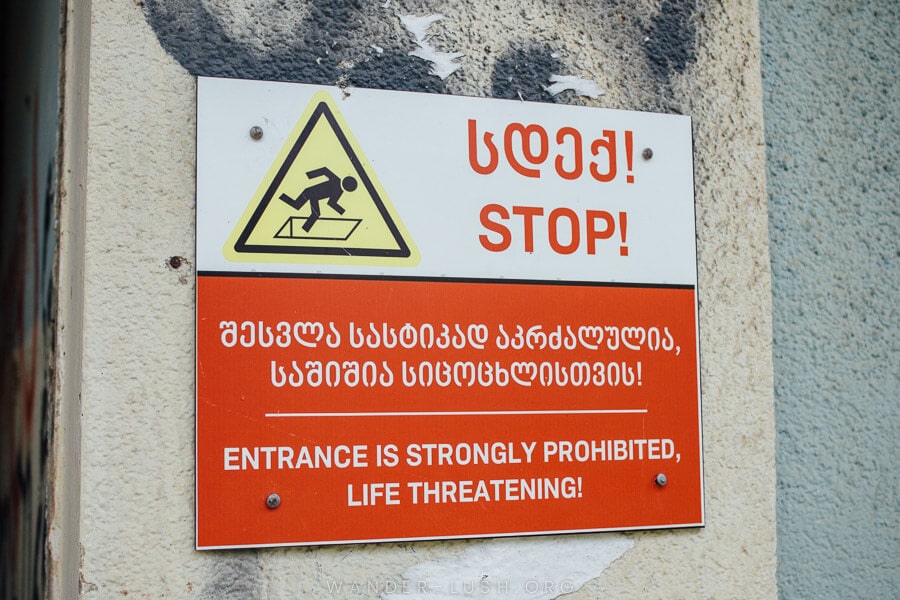
In the last few years, these strongly worded signs have been put up at a few of the old bathhouses.
There are lots and lots of street dogs in Tskaltubo. In my experience they are all very friendly and will want to accompany you around and play tour guide. Do be on the lookout for territorial dogs that might be guarding property or livestock.
In terms of personal safety, I have never heard of travellers having any issues in Tskaltubo. As with the rest of Georgia, it’s a generally safe place. As a woman, I would probably not feel safe wandering around alone, purely because there aren’t many people around and some sanatoria require you to go down remote roads and paths. Best to buddy up if you’re a solo traveller.
Planning your visit to Tskaltubo
Best time to visit Tskaltubo
Tskaltubo is blisteringly hot in summer. Because everything is outdoors, I strongly recommend you avoid visiting in July or August (peak summer is my least favourite time of year in Georgia).
In autumn, temperatures are much more pleasant and the park puts on an amazing display of fall foliage. I recently visited in the first week of November and saw some incredible maple trees.

Autumn colours in Tskaltubo. This photo was taken in the first week of November.
Winter is also a good option. Tskaltubo is very leafy and the park is green year-round, but it’s easier to see some of the buildings and architectural details when the trees branches are bare.
How much time do you need in Tskaltubo?
Tskaltubo might look small on the map, but it’s deceptively big. Visiting the sanatoria and bathhouses involves a lot of walking.
Most people come on a day trip from Kutaisi, which is enough time to see four to six buildings in detail. That’s about the limit. Anything more and you’ll be exhausted.
If you want to see everything on this list, you’ll need at least two full days. See the next section for time-saving tips and my recommended walking route.
What to take with you
You don’t really need to bring anything special with you apart from good walking shoes, a hat and extra camera batteries. There are ATMs (TBC and Liberty Bank) in town, plus a few convenience stores where you can buy bottled water and snacks.
Tskalutbo has a couple of good cafes and restaurants for lunch or dinner – you can find my recommendations at the end of this article.
How to get to Tskaltubo
Kutaisi to Tskaltubo
Tskaltubo is around 15km north-west of Kutaisi (20-25 minutes by road) and very easy to reach with either a taxi or public transport.
From the Colchis Fountain, a taxi booked through Bolt costs 15-20 GEL.
Alternatively, there are two frequent marshrutka minivans to Tskaltubo. The more convenient of the two is the #30, which departs from the end of the Red Bridge (drivers wait here) every 20 minutes between 7.30am and 7pm. The fare is 2 GEL.
The #34 departs from Kutaisi Central Bus Station (see the exact location here) once an hour between 9am and 6pm. To get to the Central Bus Station, you can take city bus #1 from the bottom of the park (see the exact pick-up location here) for 60 tetri. The fare to Tskaltubo is 2 GEL.
Once in Tskaltubo, vans follow Rustaveli Street along the eastern edge of the park. You can jump out anywhere – or if you’re following my walking route, wait until you reach the top of the park.
Tskaltubo to Kutaisi (return trip)
To get back to Kutaisi from Tskaltubo, you can simply flag down a marshrutka travelling the opposite way down the road on the eastern side of the park. Drivers will stop for you at any point, but I usually wait under the bus shelter in front of the Sports Palace. Travel time and fares are the same.
Alternatively, there are plenty of taxi drivers waiting in front of the post office at the top of the park and outside the Central Market. A regular taxi (not booked through Bolt) should cost around the same – we paid 20 GEL on our last visit. Bolt sometimes works, but often you’ll find there are no drivers available.
Tbilisi to Tskaltubo
Tskaltubo is 240km or at least 4 hours by road from Tbilisi, so it’s not really feasible to visit as a day trip using public transport. To the best of my knowledge there are no direct marshrutka connections, meaning you’d have to change vans in Kutaisi or possibly in Zestafoni.
If you only have a day and you need to travel from Tbilisi, the only option is to join a guided tour or hire a car/car and driver. Private transfers start from 230 GEL return when booked through GoTrip. Car hire starts from 35 USD/day when booked through Local Rent.
How to get around Tskaltubo
If you have a rental car, you’ll find it fairly easy to navigate Tskaltubo and find street parking. A car isn’t really necessary as the area is quite compact, but if you have mobility issues or you’re travelling in summer, it can be a good option.
Most people choose to get around Tskaltubo by foot, which is what I usually do too. To save time and energy, you might consider hiring a bicycle. The area is pretty flat and it would be enjoyable to cycle around and through the park.
Park Hotel (at the top of the park, behind Magnolia Cafe) offers bike hire for 10 GEL/hour.
Suggested Tskaltubo walking route
I recommend starting at the top of the park and working your way around Tskaltubo in an anticlockwise direction.
Alight the van or get dropped off close to Tskaltubo Plaza and visit two of the most popular sanatoria, Iveria and Shakhtiori, first. From there, make a short detour east to Sanatorium Imereti, Sanatorium Savane, the Research Institute of Resortology, and the various other hotels off Sulkhan Saba Street.
Next, cut back through the park, stopping at Bathhouse No 5, and head up the road towards the Central Market to see Sanatoriums Tbilisi, Geology, Gelati and Metalurgist. Go back the way you came and take a break at Magnolia restaurant.
Walk down the western side of the park, passing Rkinigzeli and Tskaltubo, then visit Sanatorium Medea. If you want to see Stalin’s Dacha, take a detour up the hill from here, passing two more sanatoria, Megobroka and Sakartvelo, along the way.
Follow the bottom of the park to Tskaltubo Railway Station then detour down Guramishvili Street for Hotel Aia. From there, walk into the park for springs 6 and 8 before finishing at Tskaltubo Spa Resort.
The locations of Tskaltubo’s sanatoria – even the ones occupied by IDPs – are not a secret. Everything is pinned on Google Maps but a few are listed under their Georgian or Russian names, which makes them trickier to search for.
I created this Tskaltubo map using preexisting pins. I double-checked all the locations myself. In the next section, I’ll provide more info about how to find the main entrances to each of the buildings and shortcuts you can take to save time.
Click here to open and save the map through Google Drive.
Tip: Use satellite view on Google Maps when you’re walking around – it makes it much easier to find roads and access points for the sanatoria that are tucked away off the main street.
Guide to Tskaltubo’s sanatoriums, hotels & bathhouses
This section contains descriptions and tips for visiting 17 sanatoriums/hotel, 5 bathhouses and a research institute building. To help you decide which ones to prioritise, I’ve used a purely subjective rating system:
- *** – must-visit
- ** – worth seeing
- * – only if you have time
‘Sanatorium’ and ‘hotel’ seemed to be used interchangeably, although generally the sanatoriums are bigger and grander while the hotels are more modest. As mentioned, bathhouses are only found inside the park.
You’ll notice that many of the sanatoria are named for the workers they were built to accommodate: Railway staff, soldiers, those involved in the metallurgy industry, etc. Others take their titles from Georgian history or mythology.
1. Sanatorium Iveria ***

Sanatorium Iveria.
Status update: Sanatorium Ivera is now surrounded by a new metal fence and is sadly inaccessible. You can still view the front of the building by standing atop one of the pillars on the street. But you cannot go inside.
Built in 1962, Iveria is one of the most-photographed sanatoriums in Tskaltubo. You’ll surely recognise the main entrance hall, which has blue walls and a large round opening in the ceiling that reveals the mezzanine floor. (Later when you visit Sanatorium Metalurgist, you’ll see how this cutaway design might have looked).
Iveria is completely abandoned so you can freely roam the top level (the bottom level is mostly gutted, its beams stripped and wallpaper torn down). Further back into the building, you’ll find tiled treatment rooms, a theatre, and several pieces of street art.

An art installation at Sanatorium Iveria.
Iveria was sold to investors in 2017 and is slated to be demolished and replaced with a new hotel. The security fence that was here on my first visit in 2019 is still in place – but now there are unlocked gates that you can easily walk through (but sadly this is no longer the case). It is not guarded. Enter at the front of the building on the east side, opposite the sports field, where there is a large opening in the fence.
2. Sanatorium Shakhtiori (Meshakhte) ***

Sanatorium Shakhtiori.
Status update: This sanatorium is privately owned and fenced off. At the time of my last visit, there were no longer guards at the entrance to Sanatorium Shakhtiori. It might not be possible to go inside.
Completed in 1952 by architects G.M. Khimshiashvili and G.M. Melegi, Sanatorium Shakhtiori or ‘Miners’ Sanatorium’ is one of the largest and most impressive buildings in Tskaltubo. It enjoys prime position at the top of the park and faces south towards the baths. The main entrance is accessed from the east via a driveway off the main road.
The front facade is extremely grand, with a huge fountain, towering palms, symmetrical sweeping stone staircases, and rows of infinite columns along every balcony.
Also privately owned, Shakhtiori is fenced off and guarded. If there is a guard onsite and you’re able to get inside, you’ll find the building is in pretty bad shape. Most of the smaller rooms have been completely stripped, but you can still see marble veneer columns and a tantalising array of flaking floral wallpapers.


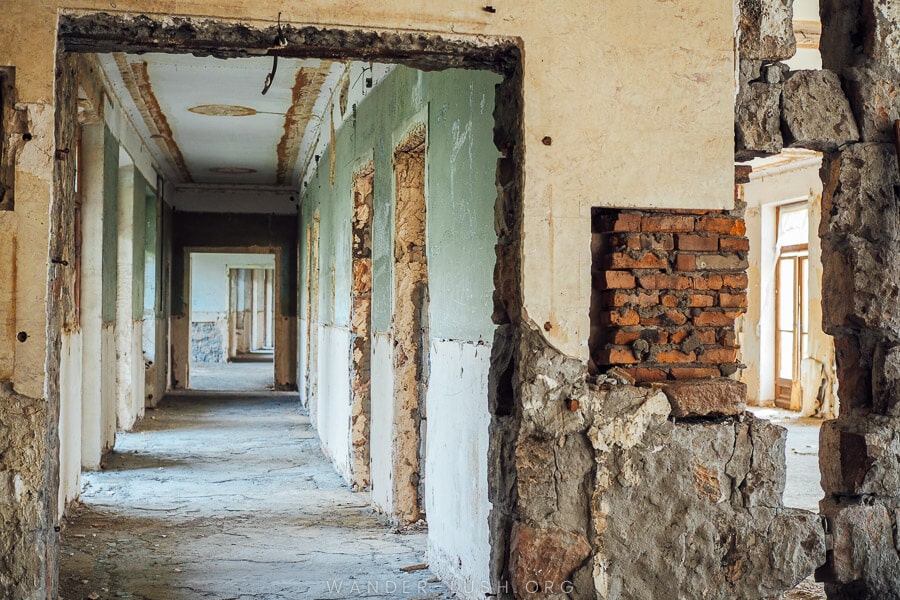
Inside Sanatorium Shakhtiori.
The real treat here is the concert hall, where a red curtain hangs limply across the stage.

The concert room at Sanatorium Shakhtiori.
Here and in the room opposite the painted ceilings are somehow in almost perfect condition, with detailed moulding and finely painted ornaments.
This sanatorium had a capacity of 350 people and was partially reconstructed in the late 1980s before it was turned into emergency housing.
3. Sanatorium Tbilisi **

Sanatorium Tbilisi – as it was back in 2022.
Status update: Sanatorium Tbilisi has been purchased by investors and is the first sanatorium undergoing renovations as part of the new Tskaltubo Masterplan. A new fence is being built around the property, the facade is being rendered (and mascarons restored, much to my delight) – and even the stone griffins have been bronzed! There are sometimes construction workers on site – they are always more than happy for me to walk around the front and take photos. You cannot go inside, though.

Construction work at Sanatorium Tbilisi. Note the newly bronzed griffin sculptures.
Built between 1950-1951, Sanatorium Tbilisi is a seven-storey building on the north-east side of the park. There is more information about this one online: I learned it was designed by Dr. V.K. Oltarzhevski and B.A. Sobolevski in the ‘late Stalinist’ style. It’s quite austere and sharp compared to some other softer designs. It had enough beds to accommodate 303 people.
As you reach the top of the stairs at the front entrance, a pair of winged mythical Griffins (not unlike those outside City Hall in Tbilisi) are there to greet you. Inside, there are several halls with beautiful marble floors – I didn’t venture too far in as there were lots of people about. (These families have since been moved on.)
Instead, I went straight through the front door into the inner open courtyard, now overgrown with plants. There are lots of little details to take in, including a rather spooky plaster head above one of the doorways.

The courtyard at Sanatorium Tbilisi.
To get there, follow the path the runs alongside the new church, just off Baratashvili Street.
4. Sanatorium Geology *

Sanatorium Geology.
Sanatorium Geology sits behind Sanatorium Tbilisi and is also accessed via Baratashvili Street. Built in 1966 and reconstructed twice in 1977 and 1991, it is a relic of Tskaltubo’s second wave of development and a total contrast to its closest neighbour, with a simple five-storey concrete facade and a flat roof.
Up until 2023, Geology was for all intents and purposes an apartment block. For this reason, I decided not to venture inside. However, its residents have since moved out. There may or may not be a security guard on the premises.
To get back to the main road from here, take the shortcut down the stairs past the new church.
5. Sanatorium Gelati ***

Sanatorium Gelati.
Completed in 1964, Gelati (named after the UNESCO monastery near Kutaisi) is slightly more ornate, with a typical Soviet-style Belvedere popping up above the roofline. As you approach the front facade you will see how residents have used bricks to block-up the spaces in the balustrades, turning what were balconies into tiny enclosed kitchens.
Head straight around to the western side where an empty courtyard leads to an empty concrete rotunda (it was probably a concert hall). Just beyond, there is an entryway with pink checkerboard tiles and blue walls.
We ran into a resident here who encouraged us to go upstairs for a look. You can only walk up one level (the rest of the way is blocked), but there’s a balcony where you can see the inner part of the complex. Other arches reveal long hallways with old wooden chairs, makeshift rugs, and apartment doorways.
We continued around the back and found an amazing mosaic consisting of rings, curved walls and angled blocks. This is the only period children’s playground in Tskaltubo – and the reason it is located here is because Gelati was the only facility dedicated specifically to mothers and children.
In 2021, the playground was being used as a livestock pen and it was guarded by a very fierce dog. The owner of the animals has apparently moved on – taking his dog with him – and in 2023, I was able to enter the playground as it is completely open and empty. You can even climb up on the elevated concrete walkway.

Mosaics outside Sanatorium Gelati.


The mosaics are absolutely incredible and definitely worth going out of your way to see. Many of the panels are damaged, but you can clearly identify pairs of animals (deer, giraffes, griffins) in some of the panels and human characters in others.
6. Sanatorium Metalurgist ***

Sanatorium Metalurgist (AKA Sanatorium Metallurgy).
Status update: Many travellers (including me) have been asked to pay an ‘entrance fee’ for this sanatorium. Some have reported a woman requesting payment for a tour of the building. My dad (who was with a local guide) was recently asked to pay 5 GEL, while other people have been asked for as much as 40 GEL.
Metalurgist (AKA Metallurgy or Metalurg) is my favourite sanatorium in Tskaltubo because it’s in such great condition. It doesn’t require much imagination to picture what it must have looked like in its heyday in the 1960s, when metal workers from the Ferroalloy Plant in Zestafoni and the mines in Chiatura would have spent their rest days here. Restorations started in 1990 but for obvious reasons were never completed.
The building is set back in a heavily forested area: the easiest way to get inside is by following the driveway off Baratashvili Street, which starts with a hairpin turn. Two stone pillars (what’s left of the gates) mark the way towards the grand entrance, with its arched glass window and decorative stonework.
We arrived to find the heavy wooden front door wedged closed, so we decided to loop around the back instead. On the western side we found a beautiful greenhouse-like atrium with most of its glass windows still intact and a single tree sprouting from the concrete floor. Incredible.


After I first posted this photo, filmmaker Toby Andris Cayouette reached out to me and told me he had planted that tree for a project! The short film, titled Tskaltubo, ended up winning several awards.
The main entrance hall is a sight for sore eyes: The original moulding and hoop of wooden banisters around the mezzanine opening are still in great condition, while a humongous chandelier hangs in the centre.
The plasterwork on the walls is exquisite, and I love the ‘his and hers’ blue and pink elevators on the second level. The ironwork on the stairs is a work of art.


You can see old signs for the director’s office and the library still hanging (ah, don’t you miss WordArt). Inside the little library there are a few wooden shelves overflowing with books (mostly in Georgian language).

The concert hall is gutted apart from a few solitary seats and part of an organ stuck in the corner. An old TV screen sits forlornly at centre stage.


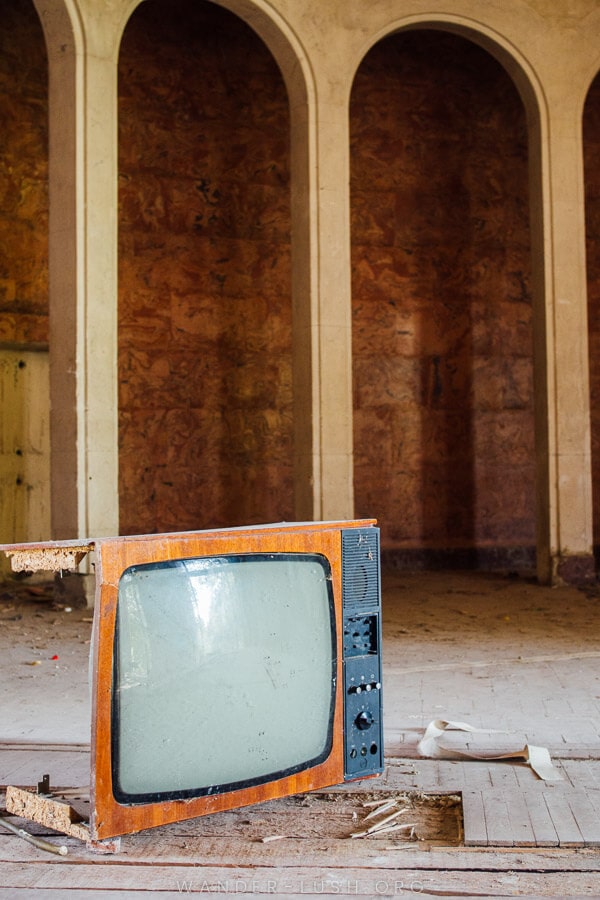
This is the only sanatorium where I felt a bit awkward – it was mid-morning when we arrived and there were lots of people around getting ready for work and school.
One man (perhaps the caretaker) was watching us and indicated that it was OK to take photos – I felt a lot better after he ducked into his apartment and brought back two mandarines for us to eat. It was a very kind gesture.
On my most recent visit, the same man approached me again at the front door and was less friendly this time. He asked if I wanted to take photos and then requested money. I politely declined and walked around the back instead.
Hopefully you can still access some of the building without him noticing or caring, but you might not be able to go into the main entryway where the chandelier is. There are still plenty of families living here.
7. Sanatorium Rkinigzeli *

Sanatorium Rkinigzeli.
Sanatorium Rkinigzeli (‘Sanatorium Railwayman’ or ‘Ironworkers’) was built in 1948 and belonged to the USSR Roads Department. Designed by V. Wevilova and N. Pociposova, it faces directly onto the park and can be seen from the main road.
At its peak, this sanatorium had enough space for 350 people. The five-storey building also contained laboratories and studios.
Today the building is occupied by IDPs. I was quite impressed with the exterior and didn’t feel the need to go inside, but you can find photos of the interior here. Some of the floors and ceiling roses are quite beautiful.
8. Sanatorium Tskaltubo *


Located just down the road from Rkinigzeli, Sanatorium Tskaltubo was built in 1936, making it one of the oldest buildings in town. It’s also very lived in – you can see the front balconies are built out to create extra space.
The stone gate posts (currently fenced off) are very beautiful and have similar designs to those at Sanatorium Medea. As you stand at the front entrance, you can look directly out to Spring 6 a short stroll away. You can imagine this must have been a desirable location as it’s so close to the baleonology zone.
9. Sanatorium Medea ***

Sanatorium Medea.
Built between 1954-1962, Medea is another of my favourites. The front facade, all columns and curved arches, is absolutely spectacular – no wonder why this is a popular spot to have your wedding photos taken.

The colonnades at Sanatorium Medea are truly stunning.
Designed by Aleksandre Intskirveli and Toma Potskhishvili, Medea was originally named Sanatorium Tsekavshiri (the new name comes from the myth of Jason and the Argonauts). I have also seen it listed as Sanatorium Tsentrosoiuzi – perhaps after the Le Corbusier-designed Centrosoyuz Building in Moscow.
Medea had 326 beds. The complex is huge, so I guess the rooms must have been quite generously proportioned.
It’s possible to follow the front stairs on either side of the building to access the roof and walk out above the main cupola. Don’t miss the fountain in the front garden on the western side – it’s the only one I’ve seen with its sculptures still in-tact.
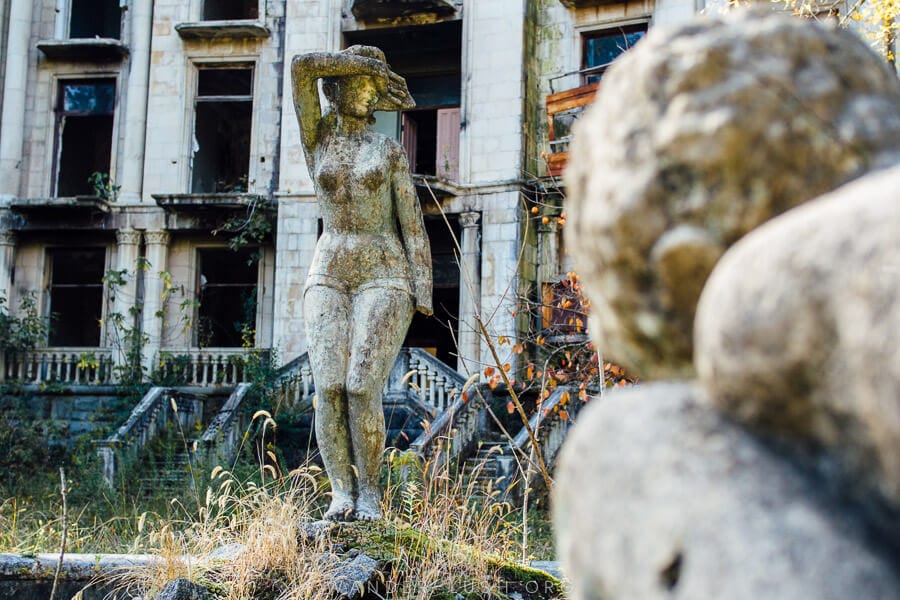
An old fountain outside Sanatorium Medea.
The entire building is now completely empty, with its former residents relocated to new apartment blocks. It is now the ‘popular’ sanatorium – whenever I come on a weekend, it is always awash with snap-happy tourists. There are never guards here. The whole place is open and freely accessible, including the back area that you previously couldn’t get to because people were living there.

You can now access the back part of Sanatorium Medea.
You are also free to wander through the apartments that have been vacated. It’s quite shocking to see the conditions people were living in up until very recently – I don’t fully understand the timeline and I don’t know when the apartments were turned over, but the place is a mess.

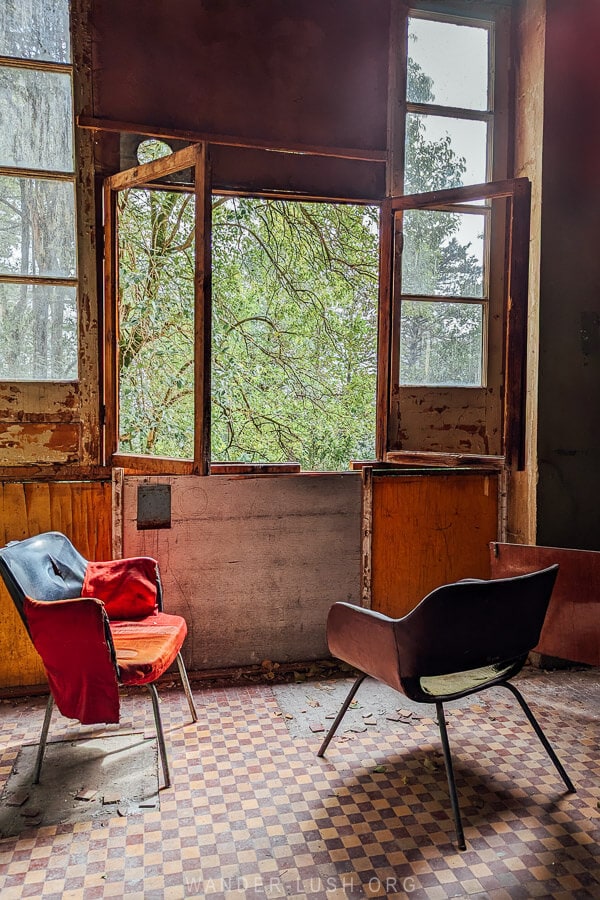

One of the apartments at Sanatorium Medea, now empty.
It looks like some people left in a big hurry, leaving behind furniture, clothing, toys and even family family photos and mementos.


I expect that work will start on Sanatorium Medea soon so it’s probably only a matter of months before it’s closed off to tourists. If you want to explore inside, now would be a good time to do it.
10. Sanatorium Megobroba *
Built between 1937-1940 by S.M. Lentovskij, Sanatoriums Megobroba and Megobroba II (AKA ‘Friendship’ and ‘Friendship II’) are two modest three-storey hotels set back off the main road.
Both are heavily occupied. I wandered down the driveway for a closer look, but they weren’t really worth photographing.
11. Sanatorium Sakartvelo **

Sanatorium Sakartvelo.
Built in 1983, the massive 500-capacity Sanatorium Sakartvelo has a striking modular facade that almost cascades down the hillside towards the main road. It still has its original roof-mounted sign, which makes it quite unique.
This hotel has been totally transformed into housing and has a number of small shops and workshops on the bottom levels. I’ve visited twice and there have always been lots of people around and kids playing in the garden.
It’s worth visiting Sakartvelo to view the perfectly kept Soviet mosaic inside. The vividly coloured, abstract design looks so strange against a backdrop of raw concrete and dirt floors – I wonder how it survived. The empty fountain in front of the mosaic wall is similarly lined with colourful tiles in an underwater-themed design.

Wall mosaic inside Sanatorium Sakartvelo.
The mosaic is located inside the back part of the building (not in the long skinny section that faces the road). If you enter from the main road, the only way to get up is to scramble along a steep, muddy path – we made this error the first time but thankfully a young boy showed us the way. Instead, it’s easier to walk up the hill and take the side street to follow the path that bends back around.
Next door, Hotel Tskaltubo (1968-1976) is another Brutalist-style hotel occupied by IDPs.
12. Intourist (Motel Tskaltubo)*

Intourist Tskaltubo.
Status update: The motel is guarded and entrance is not permitted.
I was curious to visit this hotel after I recently received a copy of the first (and only) Lonely Planet USSR travel guide. It lists the Intourist as the only accommodation in the Kutaisi-Tskaltubo area where foreigners were permitted to stay.
In the words of the authors: “It was literally rotting when we stayed… But renovation has started and hopefully it’ll soon be habitable.” Apparently that never happened.
The Intourist, designed by Rusudan Lortkipanidze in 1976, is now in a terrible state of dereliction. It was clearly occupied at some point, but it is currently empty. A guard in official uniform stands at the door and very politely denies people entry. This tells me that the building is probably government-owned.
There is a glossy brochure for the Intourist kept inside the Tskaltubo Museum (see below).
13. Hotel Aia ***

The stunning mosaic at Hotel Aia.
Crossing to the eastern side of the park, Hotel Aia is located down one of the side streets. Like Sakartvelo, it houses a spectacular Soviet-era mosaic that is well worth the detour for.
Named after the old capital of Colchis, Aia was built in 1985 specifically for employees of the USSR Ministry of Internal Affairs. It was quite lavish – it even had a casino – and its entire facade was covered in limestone tiles.
It has since been converted into apartments; when we visited around election time, this was one of the sanatoria that was gearing up to house a polling station.
The wine-themed mosaic is a colourful scene of people harvesting grapes and tending Qvevri. The rooms around the hall where the mosaic is must have been bathrooms: Some still have their blue tiles and tubs. The fact that this mosaic is still standing is pretty incredible given the horrible condition of the building. The roof is leaking and everything is water damaged.
When you stand at the front of the building, you can see a second mosaic off to the right. This one hasn’t fared so well and is partially destroyed.
14. Tskaltubo Spa Resort (Military Sanatorium) ***

The refurbished covered walkway at Tskaltubo Spa Resort.
Formerly used by the Soviet Union Ministry of Defence, this is the only sanatorium in Tskaltubo that’s been partially restored. Now known as Tskaltubo Spa Resort, the 4-star hotel with 135 rooms reopened in 2011 after extensive renovations to part of the property.
The massive 1947-built complex once had 500 beds spread over two accommodation wings linked to a central concert hall and restaurant by covered walkways. One half has been beautifully restored, the other side was left untouched – so you can compare and contrast how things might have been had the whole place been left to ruin.
Staying at the resort gives you an idea of Tskaltubo’s potential if the old hotels do finally receive the TLC they so desperately need.

The main building of the former Military Sanatorium.
Guests have free reign of the 16-hectare property and can tour the preserved concert hall, a small museum full of Soviet relics, and Stalin’s suite – which was apparently reserved for the leader. I have a feeling that someone unmade the beds and arranged the samovar to make it look more authentic. But it’s spooky nonetheless.

The restored concert hall, built in 1947.

Stalin’s suite at Tskaltubo Spa Resort. The samovar was still warm…
I recently spent the night here – read about my experience and see more photos here.
If you’re not a guest, you might be able to tour the property for a small entrance fee. There is a security post at the front of the property where you can ask.
15. Hotel Savane **

Hotel Savane.
Built in 1947, Hotel Savane sits at the north-east corner of the park. It’s completely abandoned and the inside is destroyed. I would not recommend trying to enter. The exterior front entry is the best part anyway, especially the curved portico plastered with ivy.
Three more hotels, Hotel Sinatle (1971), Hotel Samgurali (1987), and Hotel No 1 (1963) (see the next section for details) are located down the street behind Savane.

Hotel Samgurali (Samkurnalo).
We had a look around but all three were clearly occupied, with vegetable gardens blocking the paths and residents busily collecting firewood in preparation for winter.
16. Research Institute of Resortology (or Sanatorium Filiali) **

Branch of the Institute of Resortology.
This building was either a sanatorium or a research institute – or perhaps a combination of the two. On Google Maps, it’s called Kurortologiis Kvleviti Institutis Piliali or ‘Branch of the Research Institute of Resortology’. I can’t find any reference to such an institution online, but I’m sure it existed under that name or another.
I’ve also seen the building referred to as Sanatorium Filiali or ‘Sanatorium Branch’. To further complicate things, it’s located in the same spot marked ‘Hotel No 1’ on some maps. But from what I saw inside, it makes sense that this might have been a research facility rather than guest accommodation.
Built in 1939, it looks much the same as other sanatoriums in the area but with the addition of wet rooms along the periphery of the courtyard. The entrance is marked with two concrete gate posts, and the corner facade is very grand, with tall columns on two sides.
The bottom levels of the building are ruined, but some of the herringbone parquetry remains in place. There is an awful lot of debris lying around, including manilla folders and catalogue cards inscribed with patient details (this supports the research institute theory). There are a lot of old glass bottles, too, both Borjomi mineral water and Rkatsiteli wine.
On one side of the building there is a smaller version of the glassed-in walkway found at the Military Sanatorium (Legends).

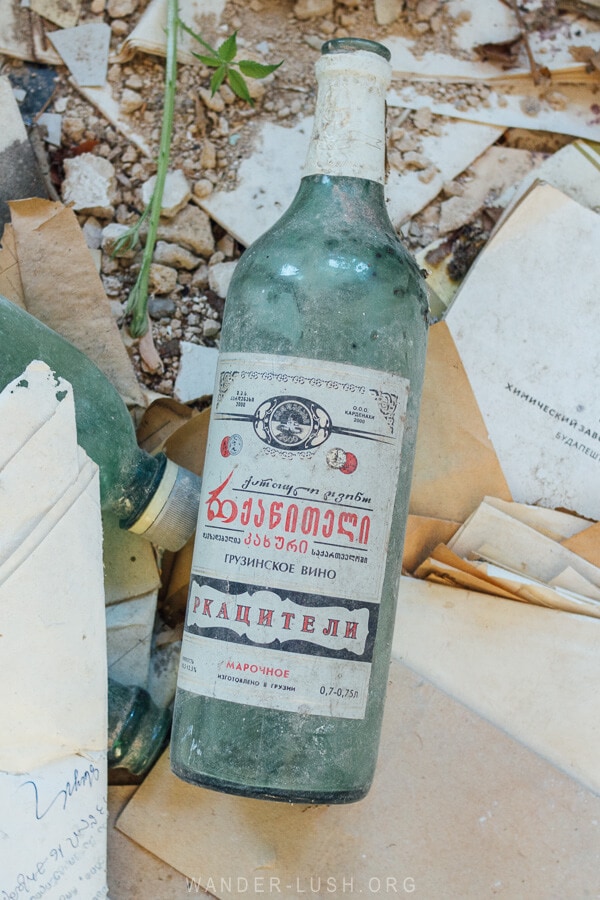
The upper floors of the western wing are clearly occupied, with washing strung between doorways in the entrance hall. When we arrived early on a Sunday morning, we met a man out front who was working on his car.
I had missed this building on my previous visits. Strangely enough, it was brought to my attention after I was served an ad on Facebook inviting me to place a bid. This is one of the buildings now being auctioned off – the asking price is 6.5 million GEL.
17. Sanatorium Imereti ***

The rotunda at Sanatorium Imereti.
Status update: Sanatorium Imereti has been purchased by investors. Some people have recently reported being barred from entering by a security guard. Others travellers have reported being able to enter without hindrance.
Built in 1961 with 450 beds, Sanatorium Imereti is another stately building with a grand double-staircase cast in black stone. The decorative columns that once stood guard now lay in pieces on the stairs.

The entrance to Sanatorium Imereti.
The right side of the building is occupied, while the entryway and left side are empty. On the far-left as you approach you’ll find a voluminous rotunda (formerly an open-air auditorium) supported by a ring of arched columns.

Sanatorium Imereti.


Designed by V. Alexi-Meskhishvili and L. Janelidzewas, it had 305 beds.
18. Hotel Tsikari *
Built in 1928 on the eastern edge of the park, nestled in a bend in the Tskaltubo river, this hotel has been reduced to its bare foundations. I walked right past it the first time and didn’t get a chance to go back for a photo.
It must be the oldest building in the area, so it’s worth having a closer look if you get the chance.
19. Bathhouse No 8 ***

Bathhouse No 8 from above.
A Tskaltubo icon, Bathhouse No 8 is the famous UFO-shaped public spa. Set under a round, curved roof, clusters of bathing ‘pods’ are arranged like flower petals around a central fountain. If you look closely, you can see where spouts must have been fixed to channel the flowing waters.
The stained concrete walls bear outlines of frolicking deer and nature scenes. Rounded brick foundations and metal brackets show you where glass screens must have stood.

Individual baths.
Sun pours in through a large circular opening in the roof. There are four entry points to the bathhouse, all easy to locate within the park. Sadly there is a lot of rubbish and debris inside. Of all the abandoned buildings, I think this is the one I would most love to see restored to its former glory.
It opened in 1959 and was designed by Georgian architect Ioseb Zaalishvili.
20. Bathhouse No 6 (Spring 6) ***
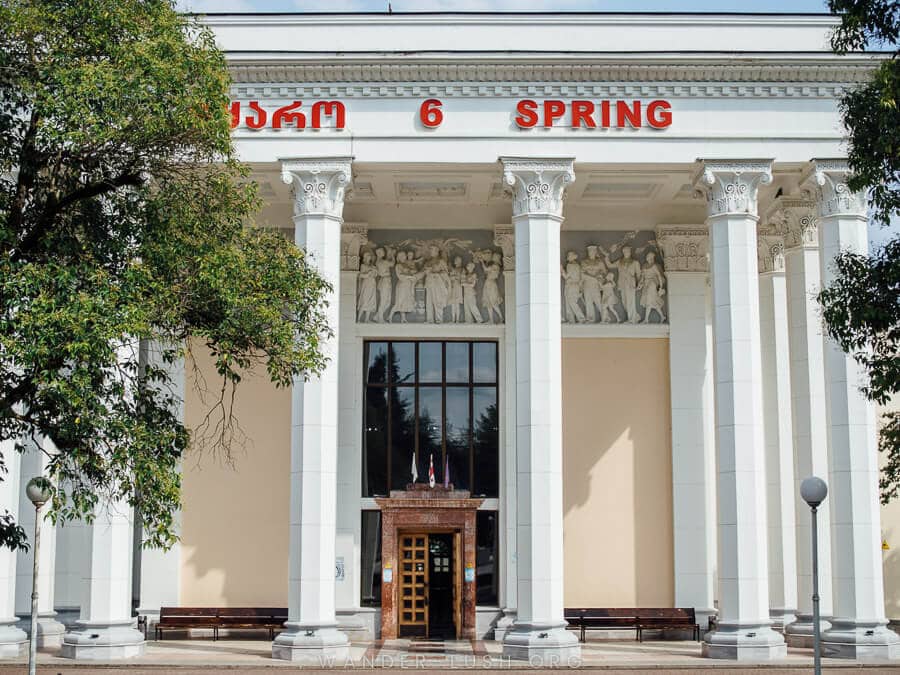
The grand Bathhouse No 6.
The largest complex within the park, Bathhouse No 6 (now called Spring 6) is one of two spas in Tskaltubo that are still functioning. Every time I visit, I see people streaming in and out the front doors.
There are three public baths and 50 individual rooms inside, with a range of treatments on offer (including some quirky ones such as Speleotherapy, “a respiratory therapy involving breathing inside a cave”).
Stalin famously had a private bathroom here – a light-filled room with a big square tub lined with beautiful horseshoe crab mosaics. It was spared during the renovations and appears much as it did when the leader frequented Tskaltubo.
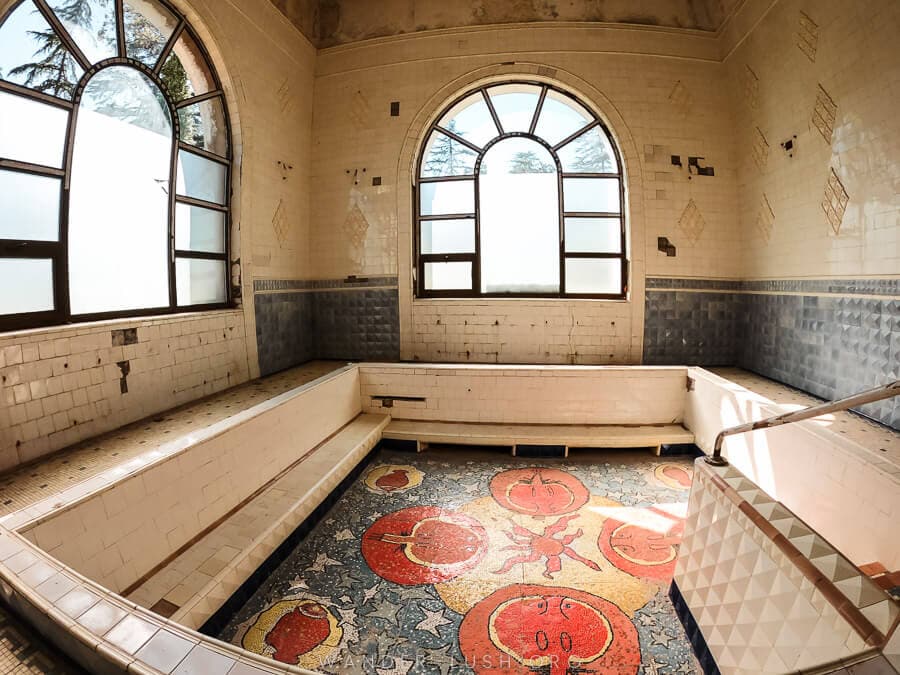
Stalin’s private bath inside Bathhouse No 6.
I was able to go inside Stalin’s room when I came to Tskaltubo with a tour group. You can try asking for permission, but there’s no guarantee – sometimes they let you in, other times they don’t. I was turned away in October 2021, but acquaintances of mine were able to enter in November after pleading with the receptionist!
Visitors are always welcome to walk into the reception area, which is opulently decorated with marble and wood. Here you’ll find a commemorative vase decorated with tiny photos of Tskaltubo in the 1950s-1970s.

This commemorative vase shows what Tskaltubo looked like in its heyday.
The bathhouse facade is extremely impressive, with Stalin depicted in the frieze above the door and a huge Jason-themed fountain out front.
21. Bathhouse No 2 (Be Healthy) *

Mosaics outside Bathhouse No 2.
Managed by Park Resort, this is the second working spa in Tskaltubo where you can go for a treatment if you wish.
It’s a more austere building. There are some beautiful Soviet-period mosaics in the front garden.
22. Bathhouse No 5 *

Bathhouse No 5.
This derelict bathhouse is the only building in Tskaltubo that I regretted going into! It’s completely ruined and the smell is almost unbearable.
Built in 1939 by Nikolai Severeov (the same architect who reconstructed the Georgian National Museum in the 1920s), it appears to have deteriorated significantly in the last few years. I’ve seen some nice photos of yellow-tiled baths that were taken here, but today, you can barely tell the colour of the tiles from all the grit and dirt.
You can view the columned facade from inside the park – at a safe distance!
Other Soviet-era landmarks in Tskaltubo
Magnolia

A taste of Tskaltubo’s old-world opulence at Magnolia.
Back in the day, Cafe Magnolia was the place to be seen in Tskaltubo. The complex was designed in the 1950s by Carlo Moretti, an Italian architect based in Tbilisi. After being abandoned, it was fully restored in 2019.
The colonnades and terraces here mirror some of the bathhouse designs from the period. The restaurant itself is quite good, making it an ideal place to stop and refuel.
Tskaltubo Railway Station

Abandoned Tskaltubo Railway Station.
When vacationers arrived in Tskaltubo by train from Moscow, the 1955-built railway station was the first thing they saw. The cream stone building is suitably grand, while the platforms are now completely overgrown (the station was repaired in 2016 but has fallen into disrepair once again – the trains that used to run here from Kutaisi are no more).

The train platform is completely deserted and overgrown.
The building temporarily reopened to house a tourist information office but since they relocated, it’s now completely abandoned. All the windows are smashed and the top level is completely empty.
Tskaltubo Post Office

Abandoned post office in Tskaltubo.
Tskaltubo’s abandoned post office is impossible to miss: The huge concrete and glass structure with a snaking ramp and brise soleil faces directly onto the main northern entrance to the park. The modern facade was added in the early 2000s before the building was abandoned in 2013.
The original building, built in the 1970s, also housed the city’s long-distance telephone service (note the aerial towers). The interior was untouched during reconstructions, and today you can see hints of what people would have been met with as they entered to collect their mail or send off a postcard, ‘From Tskaltubo with love’.
The long wooden service counter is backed by a beautiful stained glass panel. In the back rooms, there are a few safety deposit boxes – perhaps the only items of value that were too heavy to pillage.

Stained glass panel inside the post office.
The rest of the building is severely water damaged and has clearly been victimised by vandals, with the wooden signboard that hung above the mosaic torn down and scattered carelessly across the floor.
There is a beautiful bas-relief on the western side of the post office extension, behind the main building.
Stalin’s Dacha (KGB building)

Stalin’s Dacha in Tskaltubo.
Status update: Stalin’s Dacha and the area around it is now patrolled and visitors are frequently being turned away by security guards on the road leading to the area. It might not be possible to visit the old building or its vicinity.
Stalin only visited Tskaltubo a handful of times but still found an occasion to build a summer house here (an actual Stalin dacha, not like the one in Racha).
There are several structures on the lot that date to 1940, including a house, a bathhouse (you can see the tiles hanging from the walls and what looks like a chimney flue), and a huge barn. Apparently these buildings served as facilities for the KGB officers who were stationed in Tskaltubo.

An underground bomb shelter on the grounds of Stalin’s Dacha.
I spotted what looks like an underground nuclear shelter. In Tskaltubo Spa Resort we saw diagrams for radiation shelters, so I wouldn’t be surprised if there are more tunnels and hideouts lurking beneath the park and sanatoriums.
Old photo studios
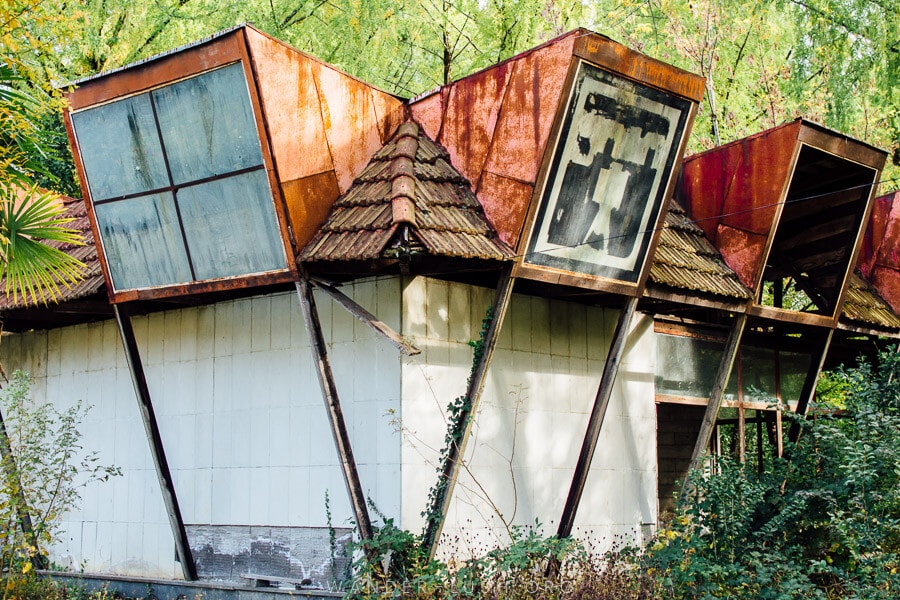
An abandoned photo studio.
There are dozens of peculiar buildings scattered inside the park – it’s fun trying to guess what purpose they might have served. After reading about the photo studios that were built in the 1970s to take happy snaps of holidaymakers, I found one of them on the main road.
It’s now located on the grounds of a medical centre, adjacent to the Park Hotel. The gate was open every time we walked past so you could easily pop in for a closer look.
Center of Culture

Tskaltubo Center of Culture.
This Brutalist building on the edge of the park houses a 1,000-seat theatre and a library. The four sculptures on the front facade created by Zurab Kajaia – four muses holding different symbols of the arts – are very striking. Known as the Concert Hall Iveria when it opened in 1987, it was something like a Palace of Culture.
Inside, the entrance hall has some very unusual, very beautiful overhead light fixtures with dangling loops of metal balls. On the back wall there are three metal sculptures depicting muses with theatre masks, film cameras and other artistic objects.


The Center of Culture appears to still be in use. I found the front door unlocked and one staff member inside who welcomed me in.
Nearby, a second theatre – the 500-seat Winter Theatre – was constructed in 1948. In 2010, it was transformed into a Sports Palace.
Assorted Soviet bas-reliefs


Don’t forget to look up when you’re roaming the streets because there are dozens of stone and concrete bas-reliefs in Tskaltubo.
The large panorama of kings, queens and mythical figures above what is now Nektari restaurant (above right) is a stunner. There is a great frieze at the former post office, and another small round ornament (above left) on the front of the Municipal Council/District Court building (formerly the Resort Museum and Central Library).
Assorted bus shelters

A retro bus shelter in Tskaltubo.
You’ll also see strangely shaped bus shelters scattered along the main roads and inside the park. I particularly like these circular ones near Hotel Sakartvelo.
More things to do in Tskaltubo
Tskaltubo Central Bazaar

Tskaltubo Central Bazaar.
Tskaltubo’s lively bazaar area is a total contrast after the quiet park and empty bathhouses. In fact the whole upper west side of town around the bazaar is a hive of activity. If you need an ATM, a convenience shop or a taxi, this is the place to go.
I recommend taking a quick walk through the undercover part. Formerly known as the Collective Farmers’ Market, it was constructed in 1973. The food sections are downstairs, while a jumble of clothes and bric-a-brac is sold on the upper level under the curved roof.
Tskaltubo Local Museum

Tskaltubo Museum.
Tskatubo’s small local lore museum is mostly devoted to archaeological objects rather than the bathhouses or Soviet history. When I was last there, the auditorium room containing archival photos of the sanatoriums was closed – but if you ask nicely, staff might let you in for a peek.
There is no English signage and in my experience, staff are apathetic. Still, it’s worth a walk through if you have time or need a shady place to escape to for half an hour. The building itself dates to the Soviet period: It was constructed in 1972 by architect Giorgi Eristavi.


One of the coolest objects on show is a goldsmith’s certificate issued by the Kutaisi General Craftsmanship Administration. It is decorated with beautiful hand-drawn illustrations of different industries.
The museum is open daily from 9am-6pm. Entrance costs 5 GEL.
Otia Ioseliani House Museum

Theatre posters and artwork at Otia Ioseliani’s House Museum in Tskaltubo.
Just up the road from the Local Museum, the house museum of author and playwright Otia Ioseliani is the more interesting of the two in my opinion. The upper level of his home looks the same as it did before his death in 2011, with bookshelves, theatre posters and all kinds of interesting objects.
Downstairs, the family has installed a cellar where they now host wine tastings. Otia’s grandson, also named Otia, also brews craft beer and makes cider. You can taste his creations at several restaurants in Kutaisi, including Sisters and Palaty.
Book in for a wine/beer degustation, lunch or dinner, or just drop in to walk around the museum. Entrance to the museum is free.
Tetra Cave & Prometheus Cave


There are two caves near Tskaltubo: Prometheus Cave (6km north) and the newly opened Tetra (White) Cave (2km east, near Tsivi Lake).
While Prometheus is impressive in scale, I preferred Tetra Cave. In the Soviet period it was used for speleology treatments and today, it is used to age wine from nearby vineyards. You can even do an underground wine tasting here.
Both are easy to reach by either local bus or taxi from the central market area.
Where to eat in Tskaltubo
- Magnolia: Eat on the terrace at this deliciously retro venue. The menu features Georgian food and cafe meals – everything we tried was good, especially the pizza. Staff are very friendly. It’s a little slice of history and my top choice of restaurant in Tskaltubo.
- Imeretian Esquisse: This new restaurant beside Magnolia has plenty of indoor and outdoor seating. The mtsvadi BBQ (cooked on an open fire) is delicious, and everything else I have ordered here (including the pkhali, the local khachapuri cooked in a clay dish and the fried cornmeal with walnut sauce) has been yummy. Prices are very reasonable.
- Lake Side: Georgian fare served on the edge of Tsivi Lake. I’ve eaten here twice now and both times everything was delicious. They do a mean iced coffee with ice cream.
- Nektari: This is a typical taverna with BBQ meat, salads and bread. It’s a safe bet if you want something quick and easy.
- Otia’s Ezo: Wine tastings and Supra-style meals served in the family home. Advance reservations are essential – details on the website.
Where to stay in Tskaltubo
There’s something unique about being in Tskaltubo after dark. Walking along the edge of the park, you can see the lights on in the sanatoriums, which in itself is quite fascinating.
If you do decide to spend the night, I highly recommend staying at Tskaltubo Spa Resort: It’s a once-in-a-lifetime kind of hotel experience where you can get a small taste for the bygone glamour that must have defined Tskaltubo.
If a guesthouse is more your scene, Art House Kutateli is a great budget choice with homely rooms and an ideal location at the top of Central Park.
Have you been to Tskaltubo? If you have any other travel tips or updates, please feel free to share them in the comments below.
More places in Georgia for Soviet history
- Zestafoni and the 1930s Ferroalloy Factory
- Gurjaani and the 1920s Red Cellar
- Dedoplistskaro and the Big Shiraki airfield
- Chiatura and Stalin’s rope roads
- Guria region and Georgia’s Tea Route
- Gori and the Stalin Museum
- Brutalist architecture in Tbilisi including the Nutsubidze Skybridge and the Chronicles of Georgia
You might also be interested in…
The ultimate Georgia itinerary: Four detailed & custom-designed itineraries
Georgia Travel Guide: All of my 200+ posts plus my top travel tips
Georgia travel tips: 25 essential things to know before you go
Places to visit in Georgia: 50+ unique & underrated destinations around the country
The best things to do in Tbilisi: Favourites, hidden gems & local picks
35+ best restaurants in Tbilisi: Where to eat Georgian food
15 best day trips from Tbilisi: With detailed transport instructions
The best time to visit Georgia: Month-by-month guide to weather, festivals & events